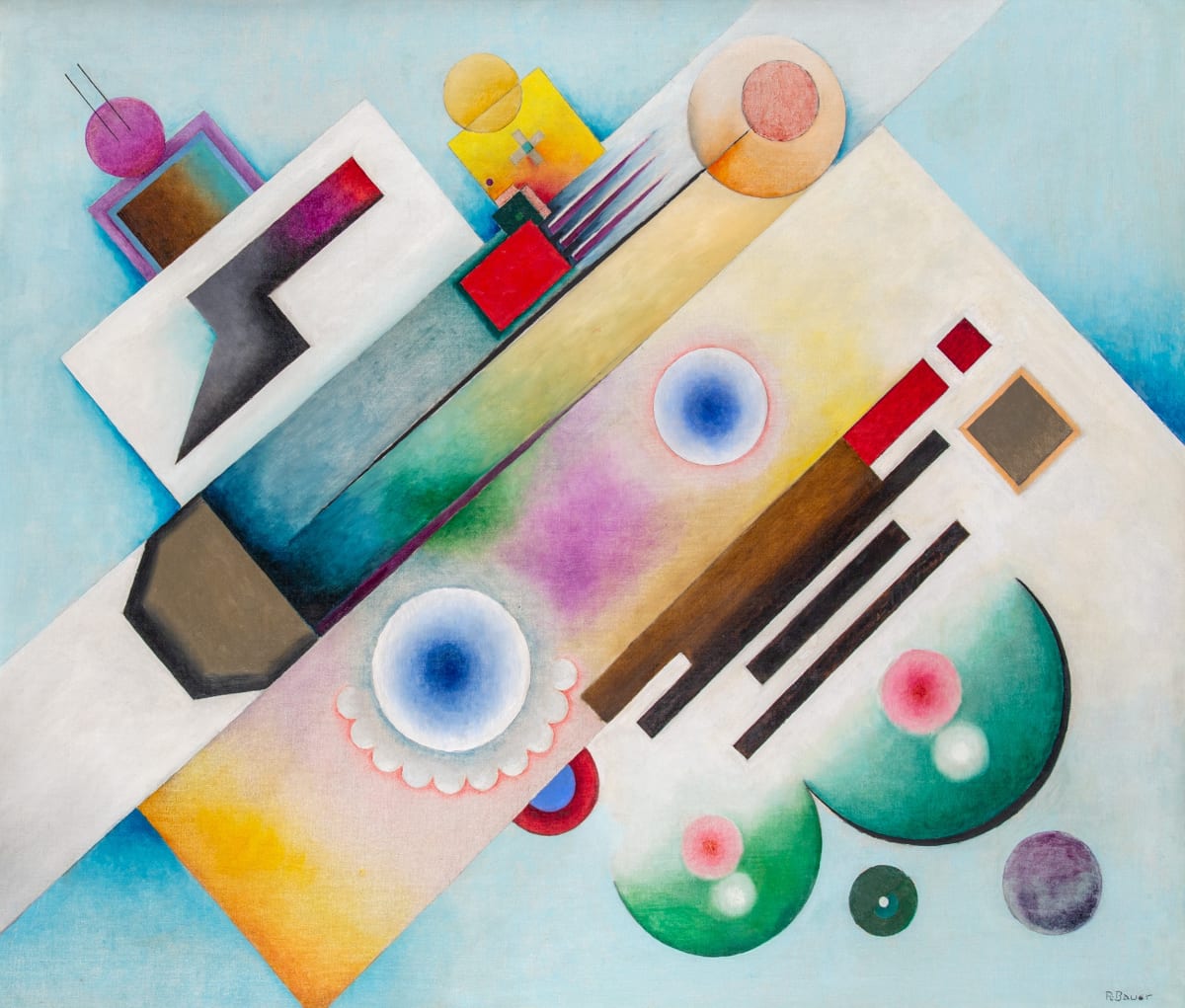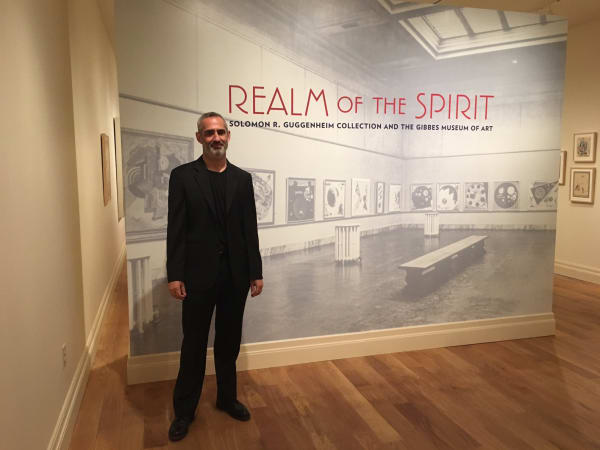Though the truth be crushed to the earth, it shall rise again and to my mind has come the realization that the many years of silence must be broken. The world must and should know the truth of my husband’s life, his hopes, his labors, his honesty and his bitter betrayal. Rudolf Bauer, artist of great spiritual scope, writer of vision, master thinker, Rudolf Bauer!
—Mrs. Louise Bauer, 1954
The true story of Rudolf Bauer is perhaps one of the most complex, tragic, and ironic of 20th century art history. Rudolf Bauer was a pioneering German-born artist who, along with Vasily Kandinsky, was among the first abstract artists in the world. His “non-objective” abstract style would go on to influence virtually all aspects of modern art and serve as a beacon to Pollock, Rothko, and other artists who formed the New York school of Abstract Expressionism. In the first half of the 20th century, Bauer’s works were displayed alongside such luminaries as Picasso, Chagall, Miró, Mondrian, and Kandinsky, in numerous galleries and museums throughout the world. However by the end of World War II, Bauer had stopped painting and fell into obscurity.
The main thing is that the picture be organic. . . . A decisive factor is whether the picture is simply a plane or a shaping of space. . . . When I limit myself to the plane I see nothing but the canvas, which is not what I see when I am working in the cosmic.
—Letter from Rudolf Bauer to Hilla Rebay, August 1917
Early in the twentieth century in Berlin, a German caricaturist and political cartoonist named Rudolf Bauer began to make his mark. While Bauer's illustrations delighted his audience and paid the bills, it was his avant-garde experiments in Cubism, Futurism, and Constructivism that stirred his soul. Bauer caught the attention of Herwarth Walden, founder of the famed Galerie Der Sturm in Berlin, who mounted three solo shows of Bauer's paintings amid exhibitions of works by Marc Chagall, Vasily Kandinsky, Paul Klee, Franz Marc, and other modernist luminaries.
In America Bauer's work was introduced to the American public in the early 1920s through the legendary Société Anonyme. Bauer's work was featured in the exhibition bulletin of the Museum of Modern Art, New York, as early as 1933. Solomon R. Guggenheim became Bauer's champion and patron and purchased more than three hundred works for his collection. A 1937 article in Time magazine cites a Bauer painting as Guggenheim's favorite and pictures the copper magnate sitting proudly in front of it. Guggenheim established a foundation for Non-Objective painting and committed to the construction of the now-famous museum on Fifth Avenue, efforts that can be argued were the direct result of Bauer's ideas.
Bauer's work The Holy One (1936) was the inspiration for the main attraction at the 1939 World's Fair, the Trylon and Perisphere buildings. Art historian Robert Rosenblum has also noted the striking similarity of Bauer's Blue Triangle (1934) to Barnett Newman's Abstract Expressionist sculpture Broken Obelisk (1963-69), one of the centerpieces of the collection of the Museum of Modern Art. The curator and art historian William Moritz has noted that "Bauer's work during the thirties and forties … was very much seen and quite influential, so no responsible history of abstract art can fail to discuss his work." Why then have the name Rudolf Bauer and his work disappeared into near oblivion? Was his erasure from the annals of art history intentional and malevolent? These are the questions that continue to stir debate, as the art world begins to rediscover the work of this visionary artist.
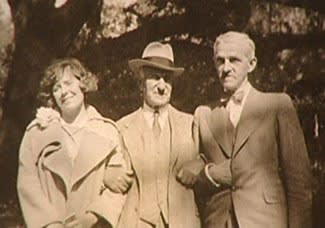
Bauer's place in art history is linked to the lives of two people: Solomon R. Guggenheim and Hilla Rebay, the Guggenheim Museum's founding director. Bauer and Rebay had met in Berlin. Rebay, in turn, had come to America and introduced Bauer's work to Guggenheim. Rebay's conviction, coupled with Guggenheim's financial resources, built her a prominent place in the history of art. Nearly single-handedly, she introduced "Non-Objective" art to the American public. Rebay was instrumental in establishing not only the Guggenheim collection but also the iconic building designed to house it, as she was the one to arrange for Frank Lloyd Wright to design this new "temple" of art on Fifth Avenue. The opening of the museum in 1959 was colored by a purge of many of Solomon Guggenheim's prized works. This change of direction, in which much of the Non-Objective art was relegated to the basement, was enacted by Harry Guggenheim, Solomon's nephew, who helmed the Foundation following Solomon's death in 1949. No artist suffered a more dramatic rise and fall in this chapter of the Guggenheim's history than Rudolf Bauer.
Early Years
Bauer was born in 1889 in Lindenwald, a town in a border region between Germany and Poland that is now part of Poland. His family moved to Berlin in the 1890s. Anecdotal evidence and a large body of highly accomplished, realistic student works suggest that Bauer was an avid artist from an early age. When the moment arrived for the fledgling artist to discuss his desire to go to art school, his father, disapproving of this choice, beat him so brutally that Bauer ran away from home, never to return. Bauer did enter art school in Charlottenburg, a suburb of Berlin, in 1905, but he was never able to count on support from his family again.
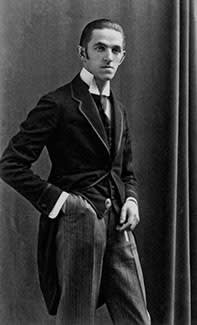
Galerie Der Sturm was founded by Herwarth Walden in Berlin in 1912, two years after the founding of the magazine of the same name. Bauer was initiated into Der Sturm (The Storm) circle around 1915 and, with his participation in a number of group exhibitions, began to put aside his commercial illustration work in favor of painting. It is likely that it was at Der Sturm that Bauer first saw the work of Kandinsky, an artist whose philosophy and approach would have a strong impact on Bauer's artistic direction. Bauer would become a fixture at Der Sturm, working as Walden's assistant and being given solo shows in 1917, 1918, and 1920. He taught at Walden's Der Sturm School, where Klee was also an instructor. This was a prolific period for Bauer. In addition to his Non-Objective work at Der Sturm, he completed a series of representational pastels depicting the horrors of World War I. References to the war may also be found in his Non-Objective art of the period. Several paintings include floating crosses—symbols, perhaps, of casualties of war. Composition 32 (1918) pictures what appears to be barbed wire running through the center of the composition. The masterpiece of this Expressionist period is White Cross (1919), a painting that Bauer considered one of his finest.
The Baroness Hilla von Rebay, also a young artist, moved in 1917 to Berlin from Zurich, where she had been studying. Her former lover the sculptor Hans (Jean) Arp had given her an introduction to Der Sturm the previous year. No longer romantically involved with Arp, Rebay met Bauer at the gallery and was courted by him. In 1919 one of Rebay's engravings was published on the cover of Der Sturm, and she was featured in a two-person show at the gallery. That same year they moved into a studio together at 25 Ahornallee in Berlin's fashionable Westend. This marked the beginning of their tempestuous lifelong relationship.
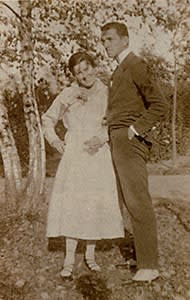
In 1920 Katherine Dreier, co-founder of the Société Anonyme (with Marcel Duchamp and Man Ray), visited Galerie Der Sturm in 1920 and purchased the Bauer oil Andante V (1915–17). Bauer was one of many European artists whose work was first introduced to the American public by Dreier. Later Dreier would say of Bauer, "We had no artist in those early years whose work so appealed to the public in general and which received so much response."
From Expressionism to Lyricism
From 1921 until 1924 Bauer's painting evolved from an expressionist to a more lyrical abstract style. The compositions became simpler, less biomorphic, and more elegant and uplifting as compared to the expressionistic work from the war-torn teens. By late 1925 or early 1926 Bauer became completely absorbed with a geometric style that would define the remainder of his career. The period seems to have been launched with the watercolor Allegro (c. 1925) and a group of similarly sized works on paper. Paintings such as Colored Swinging (1935), the four-paneled Tetraptychon series (1926-30), and his Symphony triptych (1930–34) are typical of this period's geometric forms and vibrant colorful compositions.
A Difficult Relationship
Bauer's early relationship with Rebay was affectionate but difficult. One of the factors straining the relationship was that Rebay's parents did not find Bauer to be a suitable match for their daughter. Other lifestyle preferences challenged the relationship early on. Bauer was willing to suffer privation in order to focus on his Non-Objective art, the bohemian lifestyle of a struggling artist was not for Rebay. Rebay had the means to escape and, ultimately, she did. As late as 1926, when living in Rome doing society portraits and selling her "ballet pictures," Rebay would exclaim upon receiving a letter from Bauer, "He is my boy. He was too poor to marry me."

In 1927 Rebay sailed to the United States armed with letters of introduction. Through her connections she met Mrs. Solomon Guggenheim. Eventually Rebay became friendly with the Guggenheims, and Solomon, charmed by her, asked her to paint his portrait. Solomon probably first encountered Non-Objective art at Rebay's studio in Carnegie Hall, which she had set up as an informal gallery. Rebay owned watercolors by Bauer, Kandinsky, and Klee. Rebay wrote to Bauer that Guggenheim had fallen in love with one of Bauer's watercolors and wanted to buy it. The opportunity for Rebay to prove that she was right about Bauer and Non-Objective art had arrived. Guggenheim hired Rebay as his personal curator.
Over the next several years Rebay helped Guggenheim amass what would become one of the world's greatest collections of modern art. Guggenheim collected predominantly works by Bauer and Kandinsky, many of them acquired directly through Bauer in Germany. In July of 1930, as part of a studio tour of Europe organized by Rebay, the Guggenheims traveled to France, then on to Germany to meet Vasily Kandinsky and Rudolf Bauer for the first time.
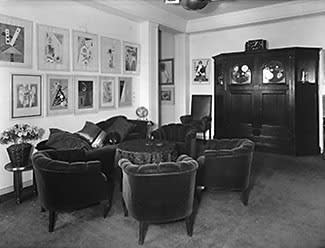
In September of 1930, flush with money from sales of his work to Guggenheim, Bauer decided the time was right to establish a new art salon in Berlin. Named Das Geistreich (The Realm of the Spirit), Bauer conceived it as a "temple of non-objectivity," a sanctuary where Guggenheim and other well-heeled buyers would congregate to choose works for their collections. It was the first museum in the world dedicated to Non-Objective art, featuring primarily the works of Bauer and Kandinsky. As Susanne Neuburger has noted, "It was the first germ of the idea that was to become the Solomon R. Guggenheim Museum." Few people in Germany were buying art, which made Bauer especially reliant on collectors from other countries. What Bauer could not anticipate was that as the decade wore on, collectors, including Guggenheim, were less and less inclined to visit Germany because of the deteriorating political situation.
Patronage and Power
Guggenheim had discovered Non-Objective art through Bauer's work and, according to his comments and letters from Rebay, liked Bauer's work best. This fact has often been slanted to imply that Bauer's work was foisted upon Guggenheim by Rebay, but it is significant to note that Rebay recognized other great artists, such as Piet Mondrian, whose work she was unable to persuade Solomon to purchase.
In spite of Guggenheim's clear admiration for Bauer's work and its inclusion in major exhibitions in Europe at Galerie Der Sturm and in the United States with the Société Anonyme, Rebay still felt compelled to trumpet his praises compulsively. Her overpromotion of the artist became notorious. Rebay featured Bauer's work on the cover of all five Guggenheim Foundation catalogues and consistently opened and closed her catalogue essays about Non-Objective art with references to Bauer and his genius. Almost every advertisement for the collection pictured a sole work by Bauer. Rebay practically demanded fealty to Bauer's work from the other artists she considered for the collection, which only served to diminish Bauer's favor in the art world. Contrary to her intentions, her determination to make him world-famous by the force of her will hurt Bauer's reputation and created great resentment. Bauer's reputation would likely have withstood the test of time had she not insisted on this rarified position for his work.
The Guggenheim Foundation
Rebay, inspired by Bauer's Das Geistreich, lobbied Guggenheim to consider founding his own museum. In 1936 Guggenheim's collection became the Solomon R. Guggenheim Foundation, with Rebay as its director. The establishment of a not-for-profit foundation served as the first legal step toward creating a museum to house the collection. While looking for suitable real estate and architects, Rebay began to organize exhibitions of the "Solomon R. Guggenheim Collection of Non-Objective Paintings." The collection had its public debut in 1936 at the Gibbes Memorial Art Gallery in Charleston, South Carolina. On a mission to illuminate Bauer's genius to a public who may never have seen Non-Objective art before, Rebay's catalogue essays, like her letters, displeased other artists in the collection such as Robert Delaunay and Kandinsky.
In 1936 Bauer traveled to the United States to attend the opening of the Guggenheim exhibition in Charleston. Since he spoke no English, Rebay served as his interpreter. This was Bauer's first visit to the United States and the first time he saw his work installed so prominently outside Germany. He visited Charleston in April, attended an exhibition of his work in Chicago in May, and spent the rest of May in New York, before returning to Germany in early June. It is clear that this trip left a favorable impression on Bauer and led him to believe that his dream of a permanent museum for his work was possible through Guggenheim.
Prison
Back in Berlin, Das Geistreich had become a lonely island of individualism in a menacing sea of Nazism. The Bauhaus had been closed down by the government in 1933, and artists such as Bauer were increasingly ostracized. Many had already fled the country. Rebay wrote Bauer in August 1937 to report that she had visited the Degenerate Art exhibition in Munich, which featured many artists from their Der Sturm days, including works by Kandinsky, Klee, Moholy-Nagy, and, of course, Bauer. Why Bauer lingered so long in this hostile environment remains a mystery. He was not Jewish, yet his patron was one of the richest Jews in the world. This association would not go unnoticed in Nazi Germany.
In July 1937 Bauer traveled to Paris because his work was included in an exhibition called Origines et développement de l'art international indépendant, organized by the Musée du Jeu de Paume. In this large survey of the period, his painting was shown alongside the work of Picasso, Georges Braque, Léger, Chagall, and Joan Miró. It is believed that while he was in Paris he received word from friends that it was too dangerous to return to Berlin; yet he ignored the warning. According to the Rebay documentarian Sigrid Faltin, it is likely that his sister, a Nazi zealot who had disowned him, turned him in to the authorities for his art. Bauer was suddenly a prisoner in Berlin. Defiant, he scavenged scraps of paper and pencils while in prison, so that he could continue to draw.
Distraught by the news that Bauer had been imprisoned, Rebay implored Guggenheim to help free him. The baroness traveled to Germany with a suitcase filled with cash to rescue the "king" of Non-Objective art. To help broker a deal with the Gestapo, Rebay asked her brother, General Franz-Hugo von Rebay, to meet with Bauer's captors, and he agreed to do so. After a couple of visits Bauer was released him unconditionally. Unwelcome and unsafe at home, Bauer made the choice to emigrate to the United States. Beset by bureaucratic difficulties in securing an exit visa and by the challenge, both emotional and physical, of packing up the contents of his home and studio, Bauer finally set sail for New York a year later in August 1939.
The Museum of Non-Objective Painting and Bauer's Life in the United States
The Museum of Non-Objective Painting showcasing the Guggenheim collection opened in New York City on June 1. The exhibition, titled Art of Tomorrow, was displayed in a former automobile showroom at 24 East 54th Street, a welcoming, comfortable, even luxurious environment where one could escape from the hubbub of New York, listen to classical music, and see the new art. The collection continued to be dominated by works by Bauer and Kandinsky.
Two months later Bauer arrived in the United States from Germany, in August 1939, to a hero's welcome. The newly freed artist stayed with Rebay at her home in Connecticut during his first four months in the U.S., after which time he suggested, probably to Rebay's dismay, that he would like a home of his own. In order to make his wish a reality, it was necessary for Bauer to settle his accounts with Solomon Guggenheim and the Foundation. Guggenheim conveyed to Rebay and Bauer the financial support he was willing to provide. In a letter from Bauer to Guggenheim, responding to Guggenheim's letter dated November 14, 1939, Bauer outlined some concerns he had regarding the purchase of his work by the Guggenheim Foundation. "It is not clear to me whether the capital invested for this purpose is to be considered the purchase price of the pictures and is to belong to me or whether I am merely to enjoy the interest." Bauer went on to discuss block discounts, leaving his estate to the Foundation in the event he was paid the cash price requested, and other matters. Perhaps the most critical point that the artist made in his letter concerned the word "output," which Bauer was unable to find in his dictionary but "the translation of which sounds bad." The implication of this wording, which Bauer sensed but did not fully grasp, was that Guggenheim was planning to lay claim to the artist's future work as well.
A few weeks later, on December 9, 1939, Bauer signed the contract, which "he believed, because of Rebay's solemn vow, was as had been outlined verbally to him." Not speaking the language and perhaps not wanting to insult his patron, who had just saved him from night and fog, Bauer signed the document, even though it had not been translated into German. In it Bauer agreed to relinquish ownership of the 110 works of art listed in Schedule A of the contract, mostly major oils, to Guggenheim in exchange for the following:
- Payment of $41,000 to purchase a grand beach house in Deal, New Jersey;
- Cancellation of a debt of $12,400;
- Payment of the $7,000 balance due on a modernist body for Bauer's Duesenberg automobile;
- Interest on a trust fund of $300,000 in Chilean Nitrate Sinking Debentures, paying 5% per annum.
The contract further dictated that Bauer was to leave his entire estate to the Foundation upon his death. It also appears that as part of this negotiation the artist was obligated to produce "ten extra large pictures special to the museum."
Bauer, trusting Rebay, signed the document, purchased the mansion in Deal, and began a new life in America, complete with an attractive, Austrian-born maid named Louise Huber hired for him by the Foundation. Shortly thereafter Bauer began translating the contract himself. He discovered that instead of a lump-sum payment of $300,000, which he had expected, the contract provided him with only $15,000 a year in interest on bonds that Guggenheim had placed in trust for him. While this was a lot of money in 1939, it is decidedly not what the artist had expected. (At this rate he would not receive the equivalent $300,000 for twenty years.) Moreover, at the end of Bauer's lifetime these debentures, along with the house, would revert back to the Solomon R. Guggenheim Foundation.
Crushed by what he perceived to be a terrible betrayal, he lost his will to paint. At the age of fifty, at the height of his artistic powers, instead of focusing on painting, Bauer became a man obsessed with protecting his creative legacy. Bauer disputed the contract, but details of the dispute and settlement are not clear. What we do know is that Bauer incurred a substantial tax burden ($40,000) based, ironically, on the assessed "selling" price of $300,000 for his work. The tax and resultant penalties alone represented nearly three years of interest from the trust. We also know that long after Bauer's death his widow left behind an estate containing mostly early paintings and a large body of works on paper, contrary to Section 3 of the contract. Mrs. Bauer and the Guggenheim Foundation reached a settlement after Bauer's death in which Mrs. Bauer paid the Foundation $20,000 to keep the pieces that remained in the artist's estate.
The 1940s
For more than a decade Bauer had been Guggenheim's favorite artist and had played a prominent role as advisor to both Rebay and Guggenheim on what to collect. As his relationship with Rebay began to deteriorate, it became clear that Bauer was to have no say in the running of the Foundation that now controlled his art. He began writing letters to Rebay and the Foundation, which were at first thoughtful and polite, but over time became less lucid, very dense, and more like James Joyce prose than business letters. The intrigue between Bauer and Rebay, triggered by Bauer's contract with Guggenheim and Rebay's unwillingness to share administration of the Foundation with Bauer, reached Shakespearean proportions around 1942. Bauer intimated to the FBI that Rebay was a Nazi spy. Rebay was investigated by the FBI and ultimately placed under arrest for hoarding coffee and sugar in her garage—the only crime they could unearth. Four days after Rebay was arrested, Bauer tried to "start a putsch" to remove the baroness from her position through an onslaught of letters to Guggenheim. This "declaration of war" was backed by members of the Foundation staff, many of whom were struggling artists too fearful previously to speak up against Rebay for fear of losing their jobs.
Lonely and isolated, Bauer found a sympathetic and willing companion in Louise Huber, his maid, and a relationship ensued. They married in 1944. This relationship provoked scathing letters and comments from Hilla, who referred to Louise in writing as a streetwalker and a whore. On behalf of Huber, Bauer sued Rebay for slander for the sum of $250,000. According to the artist Rolph Scarlett, when Rebay won the suit in 1945, primarily through the eloquence and connections of her attorney, Bauer lost the "struggle for power." The battle for control of the Foundation between Bauer and Rebay coupled with Rebay's intimate relationship with her boss were no doubt an embarrassment to the extended Guggenheim family. When Guggenheim died in 1949, the collection that Rebay and Bauer helped shape for over twenty years, and the legacy that Guggenheim had sought to establish through its exhibition, was at the mercy of the Foundation's trustees.
The creative legacy left by Solomon Guggenheim, while expanded since his death to an empire of five museums throughout the world, was shaped and shifted by his successors into a program at odds with his vision. There is strong evidence that the resentment held by so many against his curator, Hilla Rebay, and the jealousy leveled against his favorite artist—Rudolf Bauer—were influential in instigating a dramatic change in curatorial program. Three years before construction of Wright's building began, Rebay was asked to step down as director and resign from the board of trustees, and the Museum of Non-Objective Painting became the Solomon R. Guggenheim Museum. While one could assume the reason was to expand the mission of the museum to better and more broadly serve the public through both art and education, another, less altruistic and more personal, agenda was at play. Staffers reported a clear mandate issued by Harry Guggenheim to downplay the significance of the museum's founding director, Rebay, as well as Bauer and the movement they had dubbed the "Art of Tomorrow." Bauer died in November 1953, spared the humiliation of witnessing the total suppression of his work from the collection he had helped to define.
-

The Love Triangle That Birthed the Guggenheim
CULTURED Mar 28, 2023The Solomon R. Guggenheim Museum has housed masterpieces of impressionist, modern, and contemporary art in New York since its founding in 1939, and is famous...Read more -

Visionaries: Creating a Modern Guggenheim at the Solomon R. Guggenheim Museum
Feb 10, 2017Solomon R. Guggenheim ’s wholehearted embrace of modern art around the age of 68 was not so dissimilar from his philosophy for succeeding in business....Read more -

Realm of the Spirit: Solomon R. Guggenheim Collection and the Gibbes Museum of Art at the Gibbes Museum of Art
Oct 22, 2016In 1936 the Gibbes Museum of Art presented the first formal exhibition of Solomon R. Guggenheim’s collection of modern art. Featuring works by Marc Chagall,...Read more






